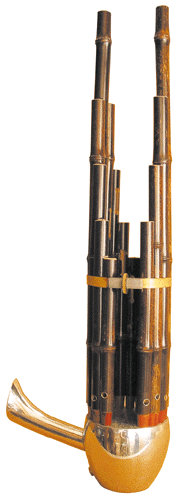|
Many people have requested
basic information on the history of the accordion, so, while many of you
are quite familiar with the background of the accordion, we thought we
would provide this brief outline tracking the beginnings of the accordion.
While the accordion itself came onto the scene in the early 1800's, we
can track the history of its components back much further. Thousands of
years ago in fact, to China.
 The
SHENG is one of the oldest Chinese musical instruments. The instrument
existed as far back as 3,000 years ago. The
SHENG is one of the oldest Chinese musical instruments. The instrument
existed as far back as 3,000 years ago.
The Sheng consists of 13-17 bamboo pipes with different lengths that are
mounted together onto a base. The base is traditionally a gourd-shaped,
wooden wind-chest with each bamboo pipe having a free reed. Sound is produced
by blowing and sucking the air through a metal tube connected to the base.
From the base the air then rushes through the other pipes.
A player determines the notes to play by allowing the air to rush through
selected pipes while pressing on selected keys near the base. By covering
two or more holes on various pipes, chords are possible, being a typical
technique used in most regional orchestras of China. The SHENG is used
as both a solo and accompaniment instrument.
By virtue of its construction, this is the only Chinese musical instrument
in the Chinese orchestra capable of playing up to six notes simultaneously.
It is therefore commonly called as the "Chinese mouth organ" by westerners.
The Sheng is also the first musical instrument in the world utilizing
a "coupled acoustical system," between an air column and a free reed.
While the Chinese were blowing their sheng, the Greeks and the Egyptians
were pumping their bellows.
Archaeologists have unearthed sculptured representations of musicians
playing bellow-operated instruments. One thing led to another, and by
medieval times there were two well-known instruments called the Portative
and the Regal. Both had bellows and a keyboard, and were in these respects,
related to the accordion. Neither had the typical accordion sound however,
which is created by the vibration of a free reed. It was from the Sheng
that the free reed principle was derived.
The Sheng could have been brought to Europe by missionaries returning
from the Orient or even by the Crusaders returning from the Holy Wars.
Whichever route it took, destiny would bring the Sheng to Berlin in 1822.
It was here that the bellows and keyboard of the Greeks joined the reeds
of the Chinese Sheng at the hands of one Christian Friedrich Ludwig Buschmann
when he built a melodic instrument with button-type keys and a push-pull
bellows which he called the Hondaoline.
By 1829, some seven years later, Cyrillus Demian from Austria was producing
and selling an improved version, a diatonic push-pull instrument with
two to four bass and chord buttons on the left side and up to 15 melody
buttons on the right.
Demian patented his instrument with the name ...accordion.
|